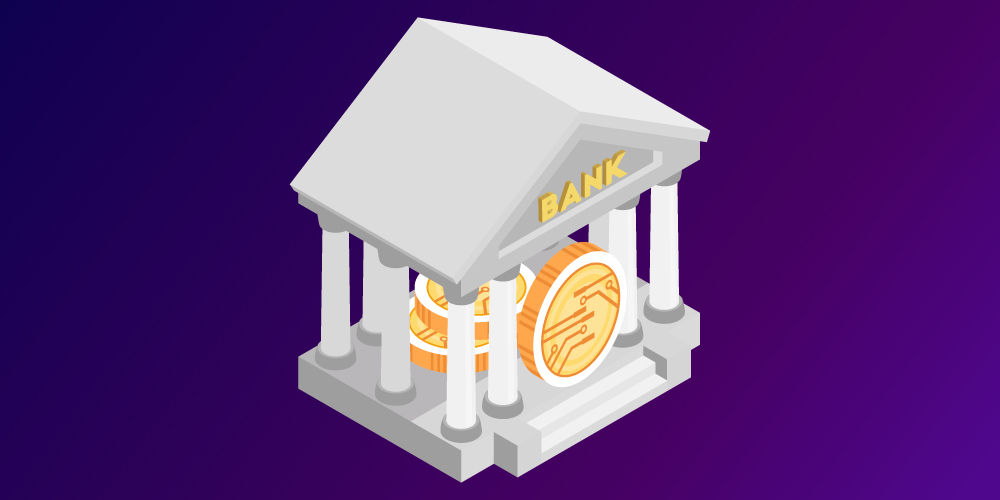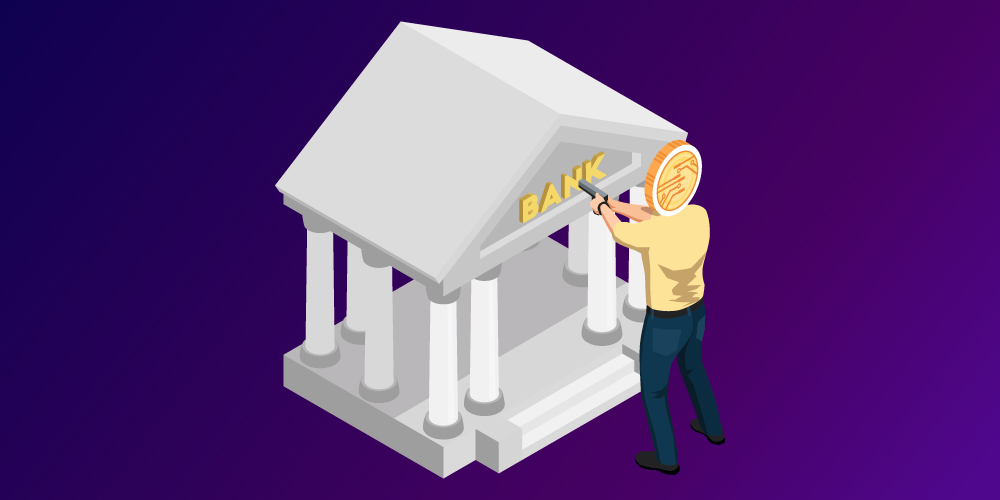What once seemed like a pipe dream-providing financial services to the masses without the need for traditional banks-is now becoming a hotly contested issue. As cryptocurrencies, blockchain technology, and decentralized finance become more popular, a seemingly radical question arises: Can cryptocurrency kill banks?
Fight for survival, or intelligent symbiosis?
As we enter an exciting new paradigm of finance and technology, many traditional institutions are struggling to keep up with the blockchain revolution.
If you’ve been following what’s happening in the world of finance for a while, then you know that traditional banks are in a bit of a bind. Thanks to multiple emergency programs and unprecedented levels of stimulus, the global economy is about to undergo major changes as we enter the digital age. Moreover, blockchain technology can trigger a paradigm shift in financial services that threatens to make traditional banks irrelevant.
In this article, we will discuss the role of blockchain and cryptocurrency in the rapidly changing landscape of payment technologies and explore how an outdated financial system must adapt to remain relevant.
Why is cryptocurrency so valuable?

As you may know, Bitcoin was the first cryptocurrency created using blockchain technology back in 2009. Since then, thousands of other cryptocurrencies and altcoins have been released.
There are different types of cryptocurrencies that serve different purposes. For example, there are stablecoins, exchange coins, DeFi coins, native tokens, and non-interchangeable tokens. It is worth noting that some coins are created just for fun, and do not have an intrinsic value.
Blockchain technology is similar to an intelligent online database, which is an open, transparent register of transactions of each individual cryptocurrency, available for public viewing.
Unlike a centralized solution, the management of this database is scientifically and mathematically verified by thousands of computers, called nodes, in a network around the world.
The transaction is validated by the node, and then placed in the block. When a block of verified transactions is filled, it is added to the block chain, where all data becomes immutable.
Blockchain technology has successfully eliminated unnecessary third-party intermediaries, such as brokers, real estate agents and banks, but has not stopped interacting with the traditional financial system. Let’s look at how this interaction happens, and how innovations replace traditional solutions.
- Visa
Crypto debit cards are one of the hottest trends this year. Recently, the Binance card, the latest Visa cryptocurrency debit card currently available, has been introduced in Europe, making using crypto assets to pay for goods and services easier than ever.
Many crypto debit cards offer solid rewards with different levels available for different financial situations. Most Visa debit cards backed by cryptocurrency offer in-app stacking rewards, cash refunds, and other perks for storing the platform’s own token.
Although these offers may not last forever, it seems that almost every day there are new tempting treats from Visa cryptocurrency debit cards. By integrating with traditional payment giants such as Visa, cryptocurrency is approaching mass adoption with privileges unmatched by any bank.
Visa has allowed users to spend their cryptocurrencies at more than 54 million retail locations around the world, and recently detailed plans to further narrow the gap between cryptocurrencies and global payments, ensuring compatibility between global payments and everyday transactions.
- Lending and borrowing
In times of economic instability, getting money into debt can be extremely difficult. Since the stock market crash in March, governments and central banks have taken extraordinary monetary and fiscal measures in an attempt to limit the risk associated with the pandemic.
The reality of this situation is that ordinary people who need credit cannot access it as easily as they used to. Large businesses are interested in borrowing money that they may not need, but often do it anyway, as it can be done at a very low interest rate.
Meanwhile, the collateral needed to secure mortgages to individuals and small businesses is growing in many parts of the world, where, due to massive unemployment, often only the best credit ratings are considered safe for lenders.
Decentralized finance platforms are changing the rules of the game by providing lending and borrowing services on the blockchain. In many cases, users can lock in crypto assets as collateral to obtain a crypto loan, while simultaneously earning free tokens just to use the platform.
In times of recession and economic downturn, getting access to credit can be difficult, and often comes at a cost. People can’t afford to risk borrowers defaulting at this time, so loans run out (unless you happen to be a zombie company that’s “too big to fail”).
DeFi is by its very nature open to anyone with an internet connection, anywhere in the world. A farmer in India has the same access to the same financial instruments as a big Wall Street businessman, which means that opportunities are not limited to the richest in society, and everyone has a better chance of climbing the socio-economic ladder.
- Non-bank crypto-financial instruments
According to a report by the World Bank Group, almost a quarter of the world’s population is not covered by banking services. Almost two-thirds of this part of humanity has access to smartphones and the Internet, which means that people have the opportunity to use alternative crypto-financial instruments.
In addition, in high-income countries, there are people who have access to a bank account but do not have proper access to the financial services that banks can offer, including savings and credit. These people are known as under – resourced bankers. In 2018, just over 25% of American citizens had little or no access to banking services.
Blockchain can allow people to create a digital identity and make transactions using a variety of financial instruments that will be at their fingertips. This applies to those who may have access to banking services due to problems with identity documents.
In addition, problems related to property rights can be restored by registering the ownership of housing on the blockchain.
- Libra
Bank of England Deputy Governor Sir John Cunliffe recently expressed concern that the cryptocurrency economy could accelerate the end of traditional bank lending as we know it, saying that Facebook’s Libra could lead to “serious economic consequences.”
If successful, Libra could become a serious threat to traditional banking, as the potential network effect is greater than that of any other payment system or cryptocurrency project, as the social media platform is currently used by more than 2 and a half billion users. However, it should also be noted that Libra faces its own challenges.
Bypassing commercial banks and eliminating intermediaries for transactional purposes can leave commercial banks completely unnecessary. If banks are still responsible for creating and preserving wealth, they must change their business model, otherwise they risk being left in the shadows.
Autonomous bank

For some crypto giants, the idea of being their own bank is the ultimate goal of cryptocurrency. In terms of maximalism, the adoption of cryptocurrency is often seen as a zero-sum game, meaning that the success of cryptocurrency depends on the decline of traditional finance.
However, in reality, the mass adoption of cryptocurrency is likely to be achieved through the integration of the blockchain into the legacy financial system, and the interaction between crypto services and banking services.
Many people do not want to be their own bank, and this is understandable. While a fundamental understanding of how blockchain technology works is an advantage for investors, it is not always a requirement. People can access digital assets in a variety of new ways, often without the need for physical ownership of the cryptocurrency, or the use of private keys.
- Derivative financial instruments
Derivatives are financial instruments that allow people to trade assets without physically holding them. Derivative financial instruments are securities whose value is determined by other assets. Common derivatives in traditional finance include futures, swaps, and options.
For example, many people like to trade gold. However, storing large amounts of gold can be problematic, and short-term transactions with physical gold will be extremely impractical. Synthetics can follow the price of a commodity without requiring the trader to consider transportation, storage, or security.
Decentralized derivatives platforms such as Synthetix allow users to issue and trade synthetic assets on Ethereum by betting on the price of real assets using ERC-20 tokens.
By blocking Synthetix network tokens (SNX), users can receive rewards and fees from the Synthetix network, as well as create synthetic assets, such as sUSD or sETH, pegged to USD ETH, respectively.
While crypto synths are still relatively new, the Synthetix platform alone has reached over $ 900 million, fixed in a parabolic month for DeFi.
So, can cryptocurrency kill banks?

Well, in the long run, it doesn’t seem too unrealistic. Given the diverse opportunities offered by the decentralized finance side, cryptocurrency can completely outperform traditional derivatives markets, lowering the barrier to participation to allow anyone, anywhere, to use these financial instruments.
In fact, if banks lose people’s trust, they are doomed to fail. The willingness of governments to help banks that act carelessly and beyond their means has led taxpayers to pay for the recklessness of others.
Meanwhile, during the economic disasters of recent years, the very people responsible for playing with the savings of ordinary citizens are being paid handsomely for neglecting this money. And they have to protect them.
If the distrust of banks becomes too strong, bankruptcy can lead to users rushing to immediately withdraw their savings, which, of course, will not be available due to the partial bank reserve. The result would be an economic disaster, as was seen in the banking panic in the United States in 1930-1931.
When banks have problems, capital controls are often applied. For example, in the United States, in 1933, Franklin D. Roosevelt issued Decree No. 6102, according to which citizens were prohibited from owning gold, for which up to ten years in prison were provided. The order required that all gold (with some exceptions, such as dentistry) be sold to the Federal Reserve in exchange for $20.67 per troy ounce.
What was supposed to be an attempt to stabilize the U.S. economy unfortunately led to a crash in 1935, when the stock market fell by 90%, followed by record unemployment.
In 1971, President Nixon abolished the gold standard, removing the dollar’s peg to gold, and allowing it to float freely in the market, relative to other currencies. Gold, which had been held by the Federal Reserve for many years, is now available again, but at an increased price of $32 an ounce.
And if history repeats itself?
Conclusion
So, can cryptocurrency kill banks? Well, it is possible, but there is a chance that cryptocurrency projects will continue to collaborate, inspire and interact with the traditional financial system.
Never before have there been so many ways to make transactions with cryptocurrency. Blockchain has become a key part of financial services and an important component of industry infrastructure.
With the advent of blockchain in businesses and a wave of new developments in digital payments, cryptocurrency is at the forefront of modern financial services, offering more than banks could ever do.
The pace of cryptocurrency development puts the industry light years ahead of the legacy financial system.
Large banks and financial institutions are already involved in the blockchain, many of which have changed their position on cryptocurrency, previously rejecting or ridiculing it.
Paypal, Visa, Mastercard… this is already happening.


